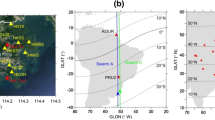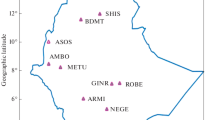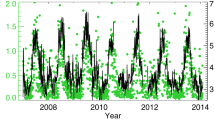Abstract
With the increase in the use of satellite-based navigation services, the forecasting of L band scintillation has turned out to be of paramount importance as it affects their accuracy and availability. Forecasting the time of occurrence or non-occurrence, strength and probable location of scintillation enables the service providers and users to take appropriate action to mitigate the effects and optimize the services. We use the recently developed method to retrieve TEC from the ionospheric correction data transmitted by the Indian satellite-based augmentation system (SBAS)–GAGAN. By making use of the established linear relation between the dusk time TEC and the maximum probable scintillation intensity (S4max), scintillation forecast maps have been generated as early as 1930 LT. The superposition of actual S4 measurements, obtained from the GAGAN network of receivers, on the forecasted S4max map shows that the actual measurements are less than the predicted S4max except on very few occasions. The potential of the simple technique to predict the 2 D maps of maximum probable scintillation index for the whole night has been demonstrated which with more refinements could evolve into a viable forecast or forewarning system.









Similar content being viewed by others
References
Aarons J (1982) Global morphology of ionospheric scintillations. Proc IEEE 70(4):360–378
Abdu MA, Alam Kherani E, Batista IS, de Paula ER, Fritts DC, Sobral JHA (2009) Gravity wave initiation of equatorial spread F/plasma bubble irregularities based on observational data from the spread F-Ex campaign. Ann Geo- phys 27(7):2607–2622
Anderson DN, Reinisch B, Valladare C, Chau J, Veliz O (2004) Forecasting the occurrence of ionospheric scintillation activity in the equatorial ionosphere on a day-to-day basis. J Atmos Terr Phys 66(17):1567–1572
Bagiya MS, Sridharan R (2011) Evolutionary phases of equatorial spread F including L band scintillations and plumes in the context of GPS total electron content variability: a case study. J Geophys Res 116:A10304. doi:10.1029/2011JA016893
Bagiya MS, Sridharan R, Sunda S (2013) Pre-assessment of the “strength” and “latitudinal extent” of L band scintillation: a case study. J Geophys Res Space Phys 118(1):488–495. doi:10.1029/2012JA017989
Bagiya MS, Sridharan R, Sunda S, Jose L, Pant TK, Choudhary R (2014) Critical assessment of the forecasting capability of L band scintillation over the magnetic equatorial region—campaign results. J Atmos Sol Terr Phys 110–111:15–22
Bagiya MS, Sridharan R, Sunda S, Jose L, Pant TK, Choudhary R (2015) Impact of the perturbation zonal velocity variation on the spatio/temporal occurrence pattern of L band scintillation —A case study. J Geophys Res Space Phys 120(7):5882–5889. doi:10.1002/2015JA021322
Basu S, MacKenzie E, Basu Su (1988) Ionospheric constraints on VHF/UHF communication links during solar maximum and minimum periods. Radio Sci 23(3):363–378
Chakraborty SK, Hajra R, DasGupta A (2012) Ionospheric scintillation near the anomaly crest in relation to the variability of ambient ionization. Radio Sci 47(2):RS2006. doi:10.1029/2011RS004942
Dabas RS, Lakshmi DR, Reddy BM (1988) Day-to-day variability in the occurrence of equatorial and low-latitude scintillations in the Indian zone. Radio Sci 33(1):89–96
de Lima GRT, Stephany S, de Paula ER, Batista IS, Abdu MA (2015) Prediction of the level of ionospheric scintillation at equatorial latitudes in Brazil using a neural network. Space Weather 13(8):446–457. doi:10.1002/2015SW001182
Groves KM et al (1997) Equatorial scintillation and systems support. Radio Sci 32(5):2047–2064. doi:10.1029/97RS00836
Manju G, Sreeja V, Sudha Ravindran S, Thampi SV (2011) Toward prediction of L band scintillation in the equatorial ionization anomaly region. J Geophys Res 116:A02307. doi:10.1029/2010JA015893
Rama Rao PVS, Gopikrishna S, Niranjan K, Prasad DSVVD (2006) Study of spatial and temporal characteristics of L-band scintillations over the Indian low latitude region and their possible effects on GPS navigation. Ann Geophys 24(6):1567–1580
Redmon RJ, Anderson D, Caton R, Bullett T (2010) A forecasting ionospheric real-time scintillation tool (FIRST). Space Weather 8(12):S12003
Saito S, Maruyama T (2007) Large-scale longitudinal variation in ionospheric height and equatorial spread-F occurrences observed by ionosondes. Geophys Res Lett 34(16):L16109. doi:10.1029/2007GL030618
Seo J, Walter T, Chiou TY, Enge P (2009) Characteristics of deep GPS signal fading due to ionospheric scintillation for aviation receiver design. Radio Sci 44(1):RS0A16
Spogli L, Alfonsi L, De Franceschi G, Romano V, Aquino MHO, Dodson A (2009) Climatology of GPS ionospheric scintillations over high and mid-latitude European regions. Ann Geophys 27(9):3429–3437. doi:10.5194/angeo-27-3429-2009
Sreeja V, Vineeth C, Pant TK, Ravindran S, Sridharan R (2009) Role of gravity wavelike seed perturbations on the triggering of ESF—A case study from unique dayglow observations. Ann Geophys 27(1):313–318
Sridharan R, Bagiya MS, Sunda S (2012) A novel method based on GPS TEC to forecast L band scintillations over the equatorial region through a case study. J Atmos Sol Terr Phys 80:230–238
Sridharan R, Bagiya MS, Sunda S, Choudhary R, Pant TK, Jose L (2014) First results on forecasting the spatial occurrence pattern of L band scintillation and its temporal evolution. J Atmos Sol Terr Phys 119:53–62
Sunda S, Vyas BM, Satish SV, Khekale PV, Parikh KS (2013) Improvement of position accuracy with GAGAN and the impact of scintillation on GNSS. Positioning 4:282–288. doi:10.4236/pos.2013.44028
Sunda S, Vyas BM, Khekale PV, Parikh KS, Satish SV, Sudhir CR, Ganeshan AS, Gera V (2014) Statistically characterizing the L-band scintillation over Indian equatorial and low latitude region. In: Proceedings of general assembly and scientific symposium (URSI GASS), 2014 XXXIth URSI, Beijing, pp 1–4. doi:10.1109/URSIGASS.2014.6929754
Sunda S, Sridharan R, Vyas BM, Khekale PV, Parikh KS, Ganeshan AS, Sudhir CR, Satish SV, Bagiya MS (2015) Satellite-based augmentation systems: a novel and cost-effective tool for ionospheric and space weather studies. Space Weather 13(1):6–15. doi:10.1002/2014SW001103
Thampi SV, Ravindran S, Pant TK, Devasia CV, Sreelatha P, Sridharan R (2006) Deterministic prediction of post-sunset ESF based on the strength and asymmetry of EIA from ground based TEC measurements: preliminary results. Geophys Res Lett 33(13):L13103. doi:10.1029/2006GL026376
Tsunoda RT (1985) Control of the seasonal and longitudinal occurrence of equatorial scintillations by the longitudinal gradient in integrated E region Pedersen conductivity. J Geophys Res 90(A1):447–456. doi:10.1029/JA090iA01p00447
Tsunoda RT (2005) On the enigma of day to day variability in equatorial spread-F. Geophys Res Lett 32(8):L08103. doi:10.1029/2005GL022512
Tsunoda RT, Yamamoto M, Tsugawa T, Hoang TL, Tulasi Ram S, Thampi SV, Chau HD, Nagatsuma T (2011) On seeding, large-scale wave structure, equatorial spread F, and scintillation over Vietnam. Geophys Res Lett 38(20):L20102. doi:10.1029/2011GL049173
Tulasiram S, Rama Rao PVS, Niranjan K, Prasad DSVVD, Sridharan R, Devsia CV, Ravindran S (2006) The role of post-sunset vertical drifts at the equator in predicting the onset of VHF scintillations during high and low sunspot activity years. Ann Geohpys 24:1609–1616
Van Dierendonck AJ, Hua Quyen (2001) Measuring Ionospheric Scintillation Effects from GPS Signals. Proc. ION AM 2001, Institute of Navigation, Albuquerque, NM, USA, June 11-13, 391-396
Whalen JA (2009) The linear dependence of GHz scintillation on electron density observed in the equatorial anomaly. Ann Geophys 27(4):1755–1761
Yadav S, Sunda S, Sridharan R (2016) The impact of the 17 March 2015, St Patrick’s day storm on the evolutionary pattern of equatorial ionization anomaly over the Indian longitudes using high resolution spatio temporal TEC maps: new insights. Space Weather 14(10):786–801. doi:10.1002/2016SW001408
Acknowledgements
The data used in the study are part of the GAGAN project, a joint collaboration between AAI and ISRO. S.S. duly acknowledges the AAI for the support and SAC (ISRO) for hosting his position. R.S. duly recognize the National Academy of Sciences Allahabad for the NASI Sr. Scientist position and also director PRL for hosting the positions.
Author information
Authors and Affiliations
Corresponding author
Rights and permissions
About this article
Cite this article
Sunda, S., Yadav, S., Sridharan, R. et al. SBAS-derived TEC maps: a new tool to forecast the spatial maps of maximum probable scintillation index over India. GPS Solut 21, 1469–1478 (2017). https://doi.org/10.1007/s10291-017-0625-6
Received:
Accepted:
Published:
Issue Date:
DOI: https://doi.org/10.1007/s10291-017-0625-6




